August 2023 Newsletter
Only a couple of months and HVTT17 starts! OMG! Well done to the organizers, your patience with all of us authors and attendees hopefully will be rewarded…
 |
| Figure 1 – Road Sign in La Puna |
Well, it has been a bumpy road since last HVTT and I am looking forward to meeting you all. In this particular newsletter, I would like to write about lithium mining in South America´s “lithium triangle” and how multinational companies´ sustainable reporting requirements on their global supply chains may be just the right trigger to motivate local transport companies in the use of safe and productive heavy vehicle transport technologies and systems. By the way, it is the subject that I shall be presenting in Brisbane as well.
Lithium has become a key element in the transition of the global economy from fossil fuel to renewable energy. The World Economic Forum wrote in January 2023 that the projected demand for lithium carbonate equivalent (LCE) suggests production needs to triple by 2025 and increase nearly six-fold by 2030, from 2021 production. As an aside, although important to take into account, LCE price is and has been variable, but continues to be highly profitable.
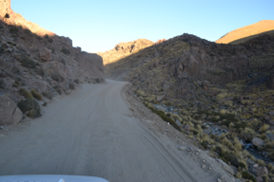 |
| Figure 2 – It is not a one way road… |
One of the places where lithium comes from is the so-called South America´s “lithium triangle”, an area that holds an estimated 45 percent of global proven lithium reserves in the world, excluding the USA, according to the U.S. Geological Survey of January 2023. Also known as La Puna, it is an arid, mostly uninhabited plateau with elevations of around 4,500m above sea level characterized by its dry, cold and changing climate. Three countries, Argentina, Bolivia and Chile, share borders in La Puna -hence the name of “triangle”.
Countries and even provincial road heavy vehicles´ regulations, standards and specifications differ, export and import rules do too. Just to keep people alert, I suppose.
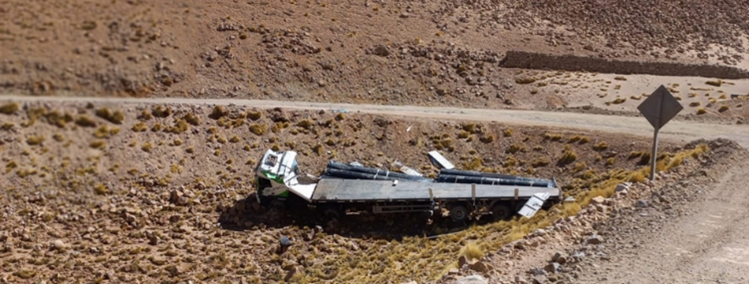 |
| Figure 3 – Aftermath of one of the many crashes, September 2022 |
Don’t let those minor issues deter you. Among the driving challenges of La Puna, thermal daily variation of 30 to 35 degrees Celsius (e.g. 13C to -20C in a single day), severe erosive processes due to blistering winds, frequent and intense frosts, ice on the road and solidified narrow creeks which can alter road position and conditions on a near daily basis, steep slopes, hairpin curves and precipices, free roaming animals and tourists in light vehicles and motorbikes, driving towards the sun for a very long periods of time and limited or non-existent communication signals for long stretches of the road will keep you alert indeed. If finding appropriate road heavy vehicle drivers is an issue normally, try finding them willing to drive in these conditions, even if their medical exam says there are fit to do so.
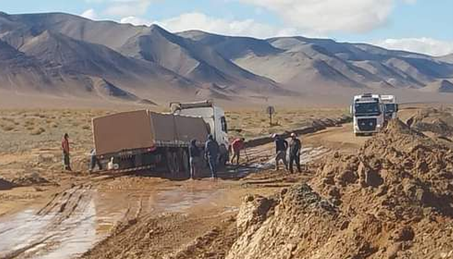 |
| Figure 4 – Road closed for many hours due to subsidence after rainfall |
Companies from Canada, China and Australia are investing in different large-scale projects in La Puna. Only in Argentina, there are currently over thirty advanced lithium projects in diverse stages of development (feasibility studies, exploration, construction, or production). With mines other than lithium such as copper, gold and silver in the area, the increase in road transport needs in the coming years (both uphill with supplies for the mines and downhill with product) is having and will have a very high social and environmental impact.
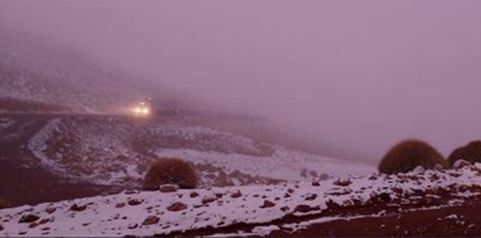 |
| Figure 5 – Summer driving daylight conditions may vary from blue skies to what the picture shows |
Capacity building has seen 200 locals recently graduate from a 7-month Puna drivers’ course which includes, besides driving skills, basic mechanics, emergency English, first aids and road safety. Another High-Altitude Driver course started only the week before this newsletter, which includes training on the use of all the devices new trucks and trailers include. These two courses are voluntary for the time being. In the meantime, the Chamber of Transporters presented a preliminary project for the creation of a Puna Jurisdiction National License or at least a certification to be able to access mining operations to reduce accident rates.
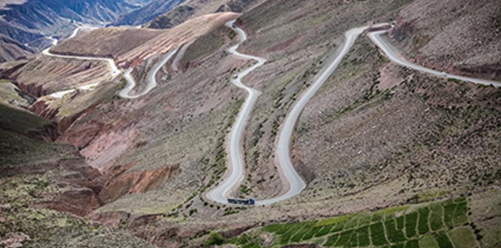 |
| Figure 6 – Lipan Slope (slope descends from 4170 meters down to 2,192 in only 17km). |
Training is essential, since for example, the Lipan Slope descends from 4170 meters above sea level to 2192meters in only 17 km, so knowing how to use properly all the different types of brakes in your truck is a matter of life or death.
Achieving gender equality and empowering women is one of the UN Sustainable Development Goals (SDG5); the safety devices in newer trucks and working conditions mean that female drivers are becoming more attracted to the job of driving heavy vehicles. And have reportedly less accidents. A strategic plan seeks to incorporate the gender perspective, assigning a quota of 30% for the incorporation of women as drivers, operators, and managers. Also, some transport companies are hiring Health, Safety and Environment professionals to help them with the sustainable reporting their global clients require. As well as placing orders to increase their fleet with newer, safer and more powerful vehicles.
Would you like to know more about all this? Paraphrasing Mr. Alfred Doolittle in My Fair Lady, “I am willing to tell you, I am wanting to tell you, I am waiting to tell you”.
Ale Efron
HVTT Vice-President: South and Central America
